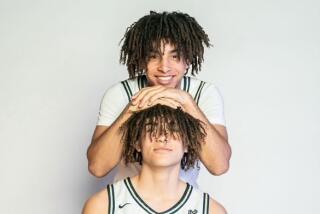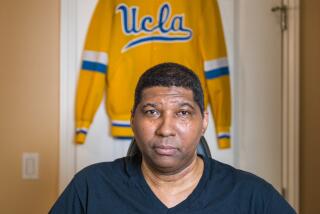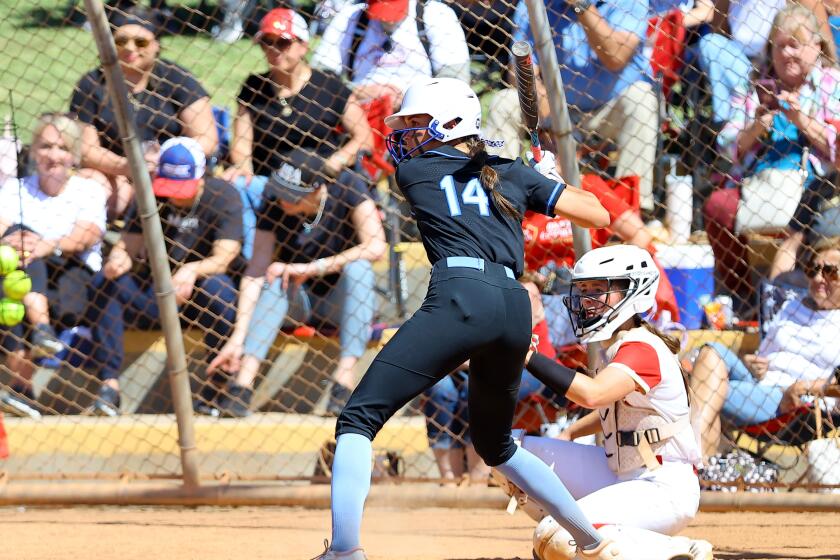Playing Hurt Indeed
- Share via
The football coach at Los Angeles Daniel Murphy High wondered all season why star running back Lawrence Hollis, a diligent kid who poured every ounce of energy into games and practices, never showed up for team meetings on Saturdays.
Too good-natured to confront Hollis, Coach Albert Carrillo could only speculate: Was the kid lazy? Indifferent?
Turns out he was bedridden.
Hollis had been shot during an incident on Labor Day, 1999, the .9-millimeter bullet piercing his right thigh and lodging in his rectum. Doctors told the sophomore he would have to leave the bullet untouched or risk complications that could necessitate a colostomy.
Then they delivered even more devastating news: He would never run again.
“That’s what they said,” Hollis recalled, “but I had to prove them wrong.”
This fall, only two years after his ordeal, the senior captain led Daniel Murphy to its first Santa Fe League title since 1994 by rushing for 1,315 yards and scoring 24 touchdowns. The Nobles (5-3) host Twentynine Palms (8-2) Friday at Jackie Robinson Stadium in a Southern Section Division XII first-round playoff game.
The stress of carrying the ball nearly 16 times per game takes its toll on Hollis, who has suffered permanent nerve damage and has little sensation in his right foot. After games, he is bedridden, his leg in excruciating pain, for two days--thus his inability to attend Saturday team meetings.
Carrillo knew Hollis had been shot, but the first-year coach didn’t know the player endured so much pain until a family member clued him in earlier this week. Hollis said he never told Carrillo because “I didn’t want him to take it easy on me. I wanted him to treat me like everyone else.”
Carrillo was nearly in tears when he learned that Hollis still carried the bullet.
“I got emotional,” Carrillo said. “I’m thinking, sometimes I get mad at him when actually I should be grateful that the kid is here playing with us. Now I want to hug the guy and say an extra thank you.”
Hollis is happy just to play for the Nobles because he realizes that his injuries could have been much worse.
He was walking home just before midnight on that fateful September day when a man on a nearby sidewalk opened fire at a group of partygoers three doors down. Hollis bolted for his front door but was hit by a bullet.
“When I got shot, it felt like a burning sensation,” Hollis said. “It was just pain. I went back in the house and started screaming, ‘I’m hit! I’m hit!”’
Paramedics rushed him to the hospital, where doctors later told him that his athletic career was over. Linda Hollis, Lawrence’s mother, said she immediately knew her son would play again. “He totally said he was going to do it,” she said.
His mother had every reason to believe him. After all, it was a rule that if you started something in the Hollis household, you had to finish it, no matter the circumstances. Lawrence always derived strength from his parents, and their influence seemed to serve him best during his arduous comeback.
Linda and Gregory Hollis took turns taking time off from work to be with their son during the month he stayed home from school. They slept in his bedroom every night. “I was afraid to be left alone,” Lawrence said. He flinched every time he heard a gun go off in the neighborhood.
Slowly, though, his recovery gained momentum. He walked on a treadmill his uncle had donated and completed exercises to build strength in the leg muscles that had atrophied.
By October, Hollis returned to school on crutches, and by Halloween, he was able to get around with the use of a cane.
A few weeks later, Hollis put down the cane to help carry his grandmother’s casket at her funeral. “I had to do it for my grandma because she was everything,” he said.
When it came to football, Hollis found it too heart-wrenching to watch his teammates go on without him.
“I was just sitting there in a wheelchair at one game, but it just brought tears to my eyes because I couldn’t watch,” he said. He stayed home on game nights the rest of the season.
But by the time the season ended, he was walking again, and he started running in January to prepare for track. He competed in the 200-and 400-meter dashes but had to give up his anchor position on the 400 relay team.
Hollis returned to the football field as a junior and had a nondescript season marred by injuries, but his comeback was just beginning to gain legs.
On a whim, Hollis decided to run the 2001 Los Angeles Marathon only two days before the race. His parents thought he was crazy. Hollis, who had never before run more than a few miles at a time, jogged a few laps around a local park. That was his entire training regimen.
Hollis started the marathon alongside friend Kenneth Scott, who vowed to stick with him the entire race. Hollis felt fine until Mile 20, when his leg ached so badly that he had to rest in a medical tent for about 30 minutes. Hollis told Scott to go on without him, and there was doubt as to whether he would be able to finish on his own--until his determination kicked back in.
“I couldn’t just stop and let everyone who had been doubting me be right,” Hollis said.
Hollis finished in slightly more than six hours, a testament to his inner fortitude. He then embraced his parents in a tearful reunion. The selfless boy wanted to cry with his parents because of all they had been through.
“They had been to games, my incident, everything in my life,” Hollis said, “so it was a good experience to see them cheering me on.”
Said Linda Hollis: “When he crossed that finish line, there was no way not to cry.”
The childhood asthmatic who outgrew the condition has continued to inspire this fall. He has trouble making cuts with his right foot yet has averaged 164 yards a game. He broke his ring finger during one game but stayed in and scored four touchdowns.
“He’s a true inspiration for the whole team,” said Greg Lange, a senior strong safety.
More to Read
Get our high school sports newsletter
Prep Rally is devoted to the SoCal high school sports experience, bringing you scores, stories and a behind-the-scenes look at what makes prep sports so popular.
You may occasionally receive promotional content from the Los Angeles Times.







